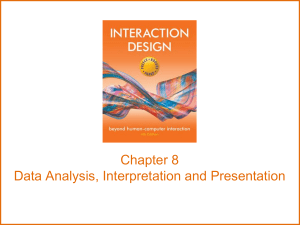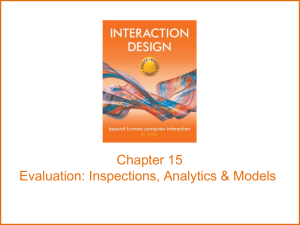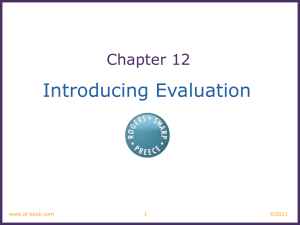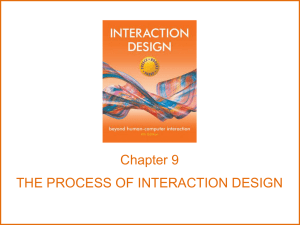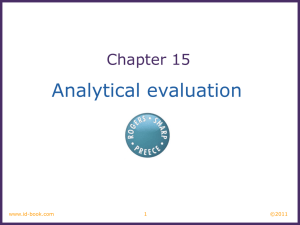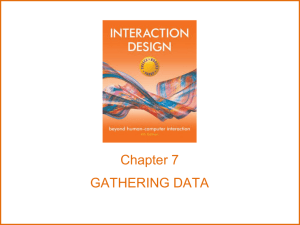Interfaces Overview Chapter 6
advertisement
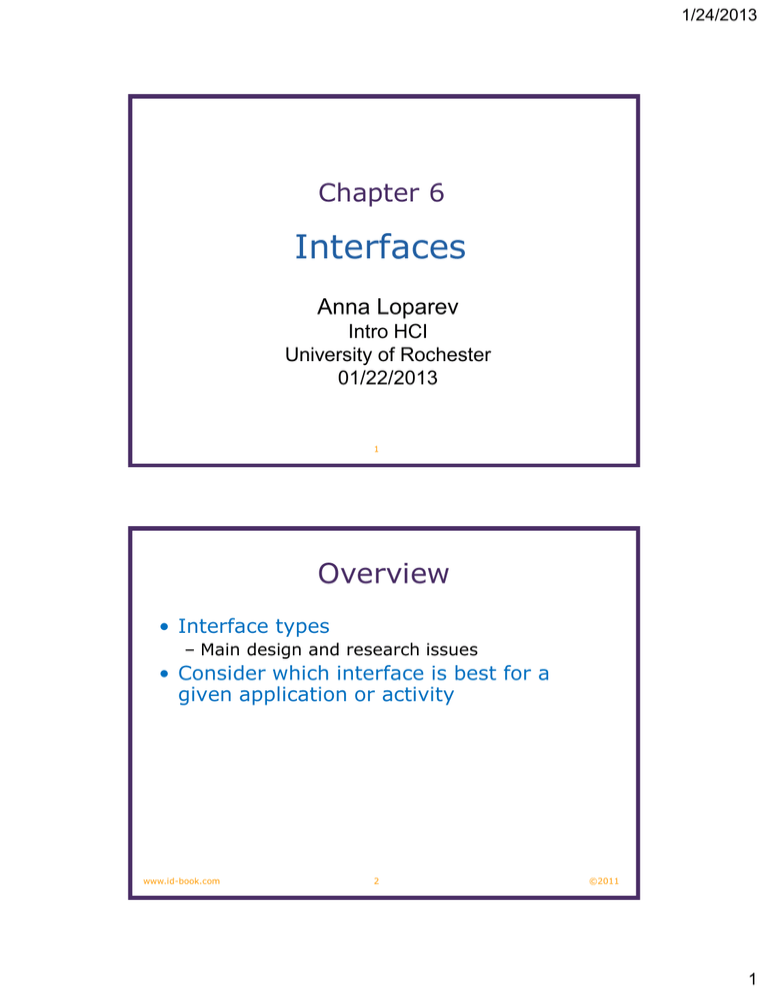
1/24/2013 Chapter 6 Interfaces Anna Loparev Intro HCI University of Rochester 01/22/2013 1 ©2011 Overview • Interface types – Main design and research issues • Consider which interface is best for a given application or activity www.id-book.com 2 ©2011 1 1/24/2013 www.id-book.com 3 ©2011 Interfaces www.id-book.com 4 ©2011 2 1/24/2013 1. Command-based • What is it? – Commands typed in at the prompt • Or key combo pressed • Or key pressed – System responds • Ex: – MS-DOS – PowerShell • Popular for – Web scripting – CS in general www.id-book.com 5 ©2011 Pros and Cons • The Good – Efficient – Low-level control • The Bad – Low visibility – Large overhead to learning set of commands www.id-book.com 6 ©2011 3 1/24/2013 Research and design issues • Form of commands – Full name, abbrev., etc. • Syntax – How combine commands • Structure – How organize options • Key principle – Consistency www.id-book.com 7 ©2011 2. WIMP and GUI • WIMP – Stands for • • • • Windows Icons Menus Pointing device – Boxy – Limited by standard widgets www.id-book.com 8 ©2011 4 1/24/2013 2. WIMP and GUI • GUI – Stands for • Graphical • User • Interface – More modern term – Non-standard widgets – New elements • Toolbars • Docks • Rollovers • Popular for – Personal computers www.id-book.com 9 ©2011 Pros and Cons • The Good – Can convey information in more ways • Can have affordances • Better visibility • Better feedback • The Bad – Less efficient • Fix: Add shortcuts • Skipping over design issues for now www.id-book.com 10 ©2011 5 1/24/2013 3. Multimedia • Combine media within single interface – Various forms of interactivity – Graphics, text, video, sound, and animations – Differs from GUI because includes web • Ex: BioBlast • Popular for – Education/Training – General Browsing www.id-book.com 11 ©2011 Pros and cons • The Good – Rapid access to multiple representations of info – Whole can be better than the parts – Can enable • Easier learning/understanding • More engagement/pleasure – Encourage exploration – Tendency to explore multiple elements at once • The Bad – Promotes fragmented interactions • Fix: Require text to be read before continuing www.id-book.com 12 ©2011 6 1/24/2013 Research and design issues • How to help explore, keep track of, and integrate the multiple representations – Require hands-on interactivities and simulations – ‘dynalinking,’ – change in window affects other(s) • Scaife and Rogers, 1996 • How best to combine for given task – – – – Audio to stimulate imagination Movies for action info Text for details Diagrams for ideas www.id-book.com 13 ©2011 Aside • NUI = Natural User Interface • Based on natural interactions www.id-book.com 14 ©2011 7 1/24/2013 4. Virtual reality • Immersive virtual simulation – Feeling of being there • • • • • Can interact and navigate in 3D Highly engaging user experiences Different viewpoints: 1st and 3rd person Ex: Second Life Popular for – Learning – Training – Overcoming phobias www.id-book.com 15 ©2011 Virtual Gorilla Project www.id-book.com 16 ©2011 8 1/24/2013 Pros and cons • The Good – Lack of danger/cost – Feels more realistic • Sense of ‘presence’ – act as if real • The Bad – Head-mounted displays • Uncomfortable to wear • Cause motion sickness and disorientation • Fix: Use desktop display – Less real www.id-book.com 17 ©2011 Research and design issues • • • • • • Prevent nausea How best to navigate How to control How best to interact with information How best to collaboration/communicate Level of realism www.id-book.com 18 ©2011 9 1/24/2013 Abstraction vs Realism • Abstraction – Simplification – More efficient • More popular with experienced users • Realism – Feel more comfortable on first encounter – Very detailed • Can overwhelm – Games • Sometimes good for novice and expert • Sometimes better only for expert www.id-book.com, 19 http://x7.fi/2010/01/18/lost-tech-put-on-your-magic-cap/ ©2011 Abstraction vs Realism • Ex: – Drag and drop vs. ctrl+x and ctrl+v – Large icons vs text – Games: http://susanpolgar.blogspot.com/2012/04/chessgrand-final-starts-tanauan-city.html http://newbreview.com/review-starcraft-ii/ www.id-book.com 20 ©2011 10 1/24/2013 Types of Software www.id-book.com 21 ©2011 5. Information visualization • Interactive graphics of complex data • Help users see – Patterns – Trends – Anomalies – (Card et al, 1999) • Enhance – Discovery – Decision-making – Explanation of phenomena www.id-book.com 22 ©2011 11 1/24/2013 5. Information visualization • Popular for ‘big data’ – Maps – Finance • Ex: – Google Maps – Bloomberg www.id-book.com, 23 http://origin-www.bloomberg.com/professional/portfolio_risk_management/ ©2011 Research and design issues • • • • • • Use animation and/or interactivity? Type of grouping 2D or 3D representation Forms of navigation How much additional info to provide Simplicity www.id-book.com 24 ©2011 12 1/24/2013 6. Web • Set of interlinked docs • Vs. GUI, web has more emphasis on – Content – Use of links for navigation • Popular for – – – – – Information exchange Advertising Storage Social networking Etc. • CSC 170 www.id-book.com 25 ©2011 6. Web • Before 90s – Text based – Focus on • • • • • Ease and efficiency of navigation Simplicity Feedback Legibility Usability – Download speed a major factor www.id-book.com 26 ©2011 13 1/24/2013 6. Web • 90s – Images – Graphic design • Distinctive, striking, pleasurable – Focus on • Aesthetic appeal • Usability • Ease of maintenance www.id-book.com, 27 http://www2.warnerbros.com/spacejam/movie/cmp/tunes/tunesframes.html ©2011 6. Web www.id-book.com, 28 http://www2.warnerbros.com/spacejam/movie/cmp/tunes/tunesframes.html ©2011 14 1/24/2013 Usability versus attractive? • Ease of discovery vs. aesthetics/pleasure • Web designers are: – “thinking great literature” • Users read the web like a: – “billboard going by at 60 miles an hour” (Krug, 2000) www.id-book.com 29 ©2011 6. Web • 00s and beyond – – – – – Video User-centered editing tools Programming languages Wikis, forums, blogs, etc. PC -> Web • Email • Photo sharing – Smart phones • Listlink instead of hyperlink www.id-book.com, m.arsetechnica.com 30 ©2011 15 1/24/2013 Research and design issues • Issues similar to GUIs – How best to design, present, and structure information – System behavior • Broad audience • Key principles – Visibility • Utilize conventions – Simplicity www.id-book.com 31 ©2011 Research and design issues • Veen’s design principles 1. Where am I? 2. Where can I go? 3. What’s here? www.id-book.com, www.pandora.com 32 ©2011 16 1/24/2013 Research and design issues • Sometimes want user to get lost – Ex: www.id-book.com 33 ©2011 Types of Harware www.id-book.com 34 ©2011 17 1/24/2013 7. • • • • • Consumer electronics and appliances Everyday device in home, public place, or car And personal devices Used for short periods Minimal, if any, learning Popular for – Small, everyday tasks www.id-book.com, www.support.apple.com, 35 ©2011 http://www.zdnet.com/blog/digitalcameras/digital-photo-frames-are-more-popular-than-you-think/212 Research and design issues • Transient with short interactions • Soft vs. hard controls • Key principles – Visibility – Simplicity www.id-book.com 36 ©2011 18 1/24/2013 8. Mobile • Handheld device • Used on the move • Pervasive – Used in everyday and working life • Ex: – Order at restaurant – Multi-player gaming – QR Codes • Popular for – Light everyday tasks – Entertainment www.id-book.com 37 ©2011 Improvements • • • • Novel interactions Vertical and horizontal scrolling Simpler browsers Lots of guidelines available www.id-book.com 38 ©2011 19 1/24/2013 Pros and Cons • The Good – Do things anywhere – Entertain when boredom strikes • The Bad – Small screen – Small number of physical controls – Text entry is slow www.id-book.com 39 ©2011 Research and design issues • Have to take The Bad into account • Physical controls – Type – Where – How maps to software • Usability and preference varies – Depends on dexterity and commitment • Privacy www.id-book.com 40 ©2011 20 1/24/2013 Phone direvsity www.id-book.com 41 ©2011 Input Methods www.id-book.com 42 ©2011 21 1/24/2013 9. Speech • Person converses with system • Ex: Apple’s Siri • Popular for – Basic inquiry – Call routing – The blind and visually impaired • The Good – Not limited by input device • The Bad – Limited by tech (Natural Language Processing) www.id-book.com, https://www.apple.com/ios/siri/siri-faq/ 43 ©2011 Research and design issues • Efficient navigation – Easy recovery • Disambiguate human requests • Choice of voice – Male / Female – Dialect – Accent www.id-book.com 44 ©2011 22 1/24/2013 10. Pen • Digital writing instrument – Lightpen – Stylus • Ex: Anoto • Popular for – Taking notes – Annotation www.id-book.com, http://digitalpennews.typepad.com/blog/anoto/ 45 ©2011 Pros and cons • The Good – Users already skilled – Intuitive, direct interaction • The Bad – Small display • Hand occludes – Large display • Awkward to reach certain elements • Have to move far – Fix: Context-aware menus – Can have lag and feel clunky www.id-book.com 46 ©2011 23 1/24/2013 Research and design issues • Ergonomics • Context control • Underlying technology – Sensitivity – Proximity – Multi-pen www.id-book.com 47 ©2011 11. Touch • Interact via finger – Swipe , flick, pinch drag, tap, etc. • Ex: – Android – Flight check-in • Popular for – Phones – Tablets – Kiosks www.id-book.com, 48 http://article.wn.com/view/2007/10/01/Jetstar_plans_web_checkins_airport_kiosks/ ©2011 24 1/24/2013 Pros and Cons • The Good – Fluid, direct style of interaction • The Bad – Finger gets in the way of screen – Need bigger buttons, so less space – Slow, error-prone typing www.id-book.com 49 ©2011 Research and design issues • Is it better than mouse and keyboard? • Multi-user screens www.id-book.com 50 ©2011 25 1/24/2013 12. Air-based gestures • Physical gestures • Ex: Kinect • Popular for – Games – Home automation – Sign language recognition www.id-book.com, http://bpa.atech.edu/team3/Xbox%20Kinect.html 51 ©2011 Pros and Cons • The Good – Intuitive, direct input • The Bad – – – – People with disabilities Accuracy No physical feedback Slow navigation www.id-book.com 52 ©2011 26 1/24/2013 Research and design issues • • • • • Which gestures to use When does gesture start/end? How to differentiate gestures Are gestures aimed at the system? Would physical controller be better? www.id-book.com 53 ©2011 20. Brain-computer interface • • • • BCI Brain waves -> cursor User trained to concentrate on the task Ex: Mindwave www.id-book.com, https://www.thinkgeek.com/product/e9e5/ 54 ©2011 27 1/24/2013 Pros and Cons • The Good – System knows exactly what user wants • The Bad – Feedback • Fix: External source of feedback – Neuroscience challenge – Technological challenge www.id-book.com, 55 ©2011 Feedback www.id-book.com 56 ©2011 28 1/24/2013 13. Haptic / Tactile • Physical feedback – Force – Vibration – Current • Ex: – Cell phone vibration while typing – Video game controllers • Popular for – Simulation – Instruction www.id-book.com, http://www.videograndpa.com/?tag=ps3 57 ©2011 Research and design issues • • • • • Where to put actuators Single or sequence of ‘touches’ When to buzz Feedback intensity How feels in different contexts www.id-book.com 58 ©2011 29 1/24/2013 Hybrids www.id-book.com 59 ©2011 14. Multi-modal • Combo of inputs and outputs – touch, sight, sound, speech • Ex: Wii • Popular for – Mobile – Air based gestures – Most common is speech and vision www.id-book.com, 60 ©2011 http://www.telegraph.co.uk/news/uknews/1563076/Elderly-addicted-to-Nintendo-Wii-at-care-home.html 30 1/24/2013 Pros and Cons • The Good – Flexible – Efficient – Expressive • The Bad – More complex – Harder to calibrate www.id-book.com 61 ©2011 15. Shareable • For more than one person at a time – Multiple inputs – Sometimes simultaneous input • Ex: – DiamondTouch – SmartBoards www.id-book.com 62 ©2011 31 1/24/2013 Pros • • • • • Large interactional space Can point to and touch info Simultaneously view interactions Shared point of reference More equitable participation www.id-book.com 63 ©2011 Research and design issues • • • • Fluid, direct methods of interaction Better than traditional? Personal space Affects on collaboration – Size – Orientation – Shape www.id-book.com 64 ©2011 32 1/24/2013 16. Tangible • • • • Sensor-based Physical objects with digital representations Change to physical object has digital effect Ex: – Flow blocks – Urp • Popular for – Learning – Play – Collaboration www.id-book.com 65 ©2011 Pros and Cons • The Good – Multi-user – Diverse object interactions – Facilitates creativity • The Bad – Downsides to physical component • User may lose • Takes up space – Technological challenge www.id-book.com 66 ©2011 33 1/24/2013 Research and design issues • Coupling between physical and digital – For learning, explicit mapping – For play, implicit and unexpected mapping • Which physical artifact to use – Bricks, cubes – Sticky notes, tokens • Key principle – Physical affordance www.id-book.com 67 ©2011 17. Augmented and mixed reality • Augmented reality - virtual added to physical • Mixed reality – virtual/physical hybrid • Ex: – Map – Yelp • Popular for – – – – Medicine (original focus) Air traffic control Games Head-up Display (HUD) www.id-book.com 68 ©2011 34 1/24/2013 Pros and Cons • The Good – Can work on top of existing objects • The Bad – Technological limitations www.id-book.com 69 ©2011 Research and design issues • Form – For learning, explicit mapping – For play, implicit and unexpected mapping • When and where – Visible but not distracting • Kind of device www.id-book.com 70 ©2011 35 1/24/2013 18.Wearables • First: – Head/eyewear-mounted cameras with info lookup • Ex: – Ski jacket with integrated MP3 player controls – CuteCircuit • Popular for – Fashion – Info on the go www.id-book.com, http://www.cutecircuit.com/ 71 ©2011 Steve Mann www.id-book.com 72 ©2011 36 1/24/2013 Research and design issues • • • • • Comfort Hygiene Ease of wear How control Privacy www.id-book.com 73 ©2011 19. Robots • Four types – – – – Remote robots Domestic robots Pet robots Sociable robots • Ex – Roomba – Paro www.id-book.com 74 ©2011 37 1/24/2013 Pros and Cons • The Good – Reduce stress and loneliness – Investigate / Explore dangerous settings • The Bad – Hard to make human-like • Uncanny valley www.id-book.com 75 ©2011 Pros and Cons http://spectrum.ieee.org/automaton/robotics/humanoids/040210who-is-afraid-of-the-uncanny-valley, http://io9.com/5974136/new-video-of-machine-perceptionwww.id-book.com labs-creepy-robot-baby-shows-that-it-is-indeed-creepy 76 ©2011 38 1/24/2013 Research and design issues • Reaction to physical robots vs. virtual ones • Resemble human? – Pet interaction more believable • Human-Human or Human-Computer www.id-book.com 77 ©2011 Which interface? • • • • • • • Currently being researched Many times depends on requirements Reliability Social acceptability Privacy Ethics Location www.id-book.com 78 ©2011 39


